The California Nebula is a large emission nebula stretching across almost 2.5 degrees of the night sky in the constellation Perseus. It has an apparent magnitude of 6.0 and lies approximately 1,000 light-years away. It was named the California Nebula because its shape is reminiscent of the outline of the US State of California on a map. The nebula has the designations NGC 1499 in the New General Catalogue and Sharpless 220 (Sh2-220) in the Sharpless catalogue of emission nebulae.
The California Nebula stretches about 100 light years across. Even though it is large and has a visual magnitude of 6.0, the nebula is very difficult to observe visually because it has a low surface brightness. Its bright integrated magnitude is spread over a large area.
The nebula requires exceptionally clear, dark skies without any light pollution and the use of a rich field telescope with an Hα (H-alpha) or Hβ (H-beta) filter. An H-alpha filter is a narrow band filter that lets the H-alpha spectral lines of emission nebulae pass while blocking almost all other wavelengths. It is essential for observing challenging visual targets that emit hydrogen alpha lines.
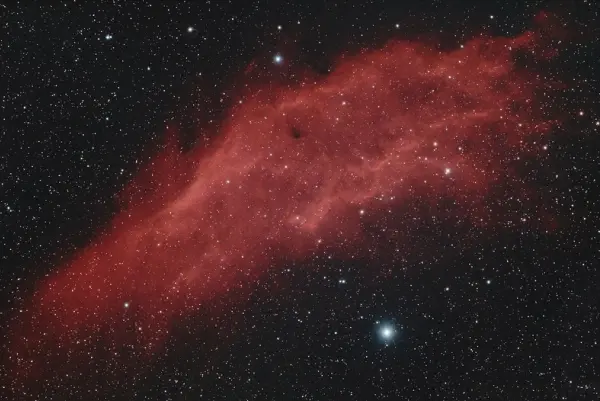
California Nebula (NGC 1499), image: Wikimedia Commons/Hewholooks (CC BY-SA 3.0)
A wide field of view is best to see the entire nebula because NGC 1499 is 2.5 degrees long and 0.5 degrees wide.
The California Nebula is formed of gases that are ionized and made fluorescent by high-energy ultraviolet photons emitted from a young, hot, blue star in the vicinity. The massive star in question, Menkib (Xi Persei), is one of the hottest stars visible to the unaided eye. It shines at magnitude 4.04 from a distance of about 1,200 light years.
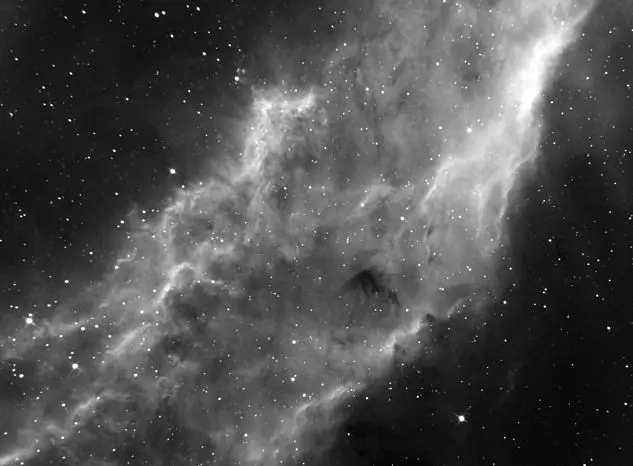
H-alpha image of NGC 1499, credit: Chuck Ayoub (CC BY-SA 4.0)
Menkib is a blue giant of the spectral type O7.5III. It has a mass 26 – 36 times that of the Sun and has expanded to a size of 14 solar radii as it evolved away from the main sequence. The star shines with 263,000 solar luminosities (bolometric) with a surface temperature of 35,000 K. It is a member of the Perseus OB2 association.
Menkib is an exceptionally fast spinner, with a projected rotational velocity of 220 km/s. The star’s estimated age is only 7 million years. Menkib has evolved quickly due to its high mass and will likely meet its fiery end as a supernova in the next million years.
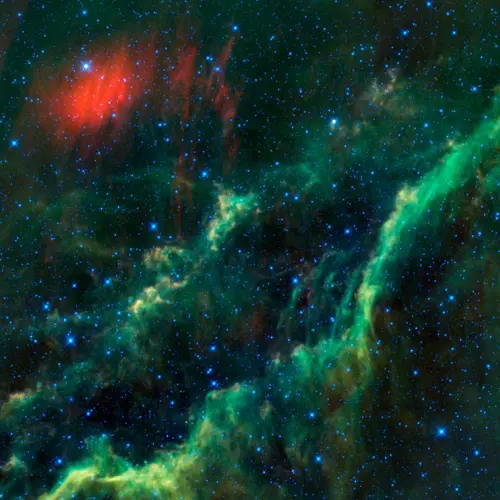
This infra-red image from NASA’s WISE (Wide-field Infrared Survey Explorer) features one of the bright stars in the constellation Perseus, named Menkib (the bright star in the upper left near the red dust cloud) along with a large star forming cloud catalogued as NGC 1499, or more commonly called the California Nebula (running diagonally through the image). Menkib is one of the hottest stars visible in the night sky. Because of its high temperature it appears blue-white to the human eye (almost all stars appear bluish to WISE). It is a runaway star, and the fast stellar wind it blows is piling up in front of it to create a shock wave in the gas and dust surrounding it in the space between the stars. This shock wave is heating up the dust within and WISE sees it as the red cloud in the upper left of the image. Menkib is part of an association of very hot stars that were born from the California Nebula only a few million years ago. These stars are lighting up the nebula; heating and ionizing it. In visible light, the ionized gas glows red, while in infra-red light we see the heated dust (which appears in green and red in this image from WISE). The entire California Nebula stretches across about 100 light-years, and we see about 80% of it in this view. All four infra-red detectors aboard WISE were used to make this image. Colour is representational: blue and cyan represent infra-red light at wavelengths of 3.4 and 4.6 microns, which is dominated by light from stars. Green and red represent light at 12 and 22 microns, which is mostly light from warm dust. Image: NASA/JPL-Caltech/WISE Team
Facts
The California Nebula was discovered by American astronomer Edward Emerson Barnard in 1884. E. E. Barnard is best-known for his catalogue of dark nebulae, his pioneering work in astrophotography, and the discovery of the high proper motion of Barnard’s Star, the fourth nearest individual star to the Sun (after the three components of the Alpha Centauri system). Other celestial objects that bear his name include Barnard’s Loop (Sh2-276), a vast emission nebula in Orion, and Barnard’s Galaxy (NGC 6822), a nearby dwarf irregular galaxy in Sagittarius.
The California Nebula is one of the largest emission nebulae in the sky by apparent size. It is about the same size as the Heart Nebula (IC 1805) in the neighbouring Cassiopeia. It appears larger than the Orion Nebula (Messier 42) in Orion, Rosette Nebula (Sh2-275) in Monoceros, Carina Nebula (NGC 3372) in Carina, Lagoon Nebula (Messier 8) in Sagittarius, and North America Nebula (NGC 7000) in Cygnus.
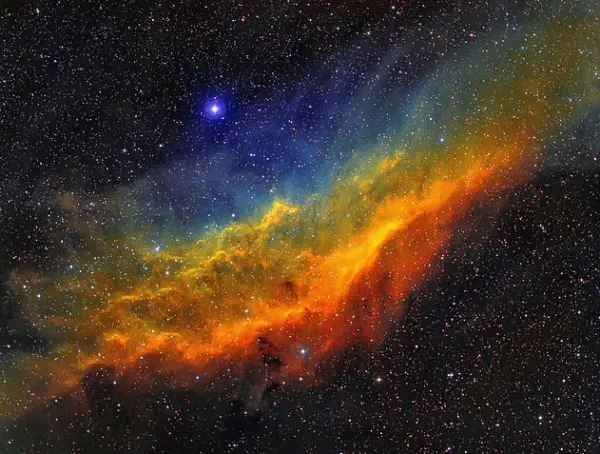
The California Nebula captured in narrowband, image: Wikimedia Commons/Remidone (CC BY-SA 4.0)
NGC 1499 lies in the Orion Arm of the Milky Way galaxy, which also contains the solar system and Earth, as well as the Pleiades, the Orion Nebula, and the open clusters M6, M7 and M44.
The size and relative brightness make the California Nebula one of the most popular targets both for astronomy enthusiasts with backyard telescopes and for astrophotographers. The nebula itself is best seen in long-exposure photographs. It appears quite large and can be photographed using only a DSLR camera and a star tracker. However, a detailed image of the California Nebula is best captured using a telescope.
The California Nebula lies at declination 36° 25’ N, which matches the geographical latitude of the State of California. The nebula, therefore, transits in the zenith in the central part of California.
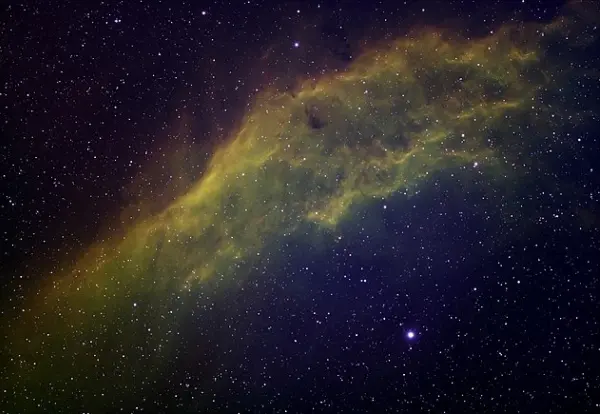
The California Nebula (narrow band in the Hubble palette), credit: Randy Dunton (CC BY-SA 4.0)
Location
The California Nebula lies in the constellation of Perseus, near the border with Taurus. It can be found about halfway between Mirfak, the brightest star in Perseus, and Aldebaran, the luminary of Taurus. The nebula appears about 3.5 degrees south of the hot blue star Epsilon Persei (mag. 2.88), the brightest star between Mirfak and Aldebaran, and just north of the magnitude 4.04 Menkib (Xi Persei).
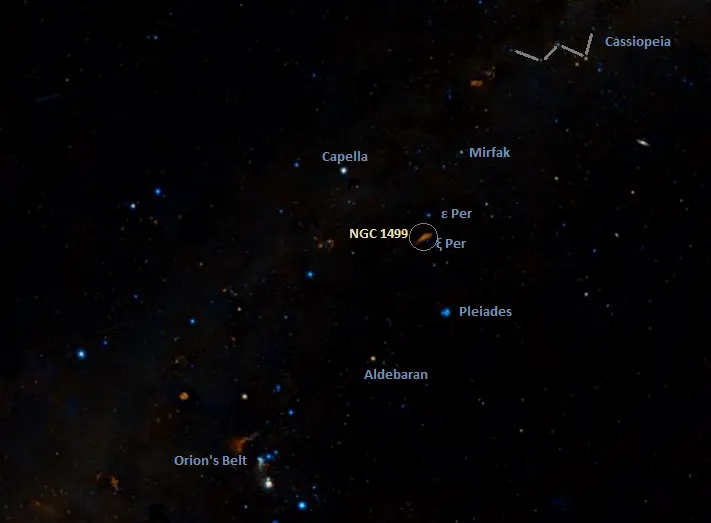
The location of the California Nebula, image: Wikisky
Aldebaran is identified as the brightest star along the imaginary line extended from Orion’s Belt in the direction of the Pleiades star cluster. Mirfak is part of the Segment of Perseus, a curving a line stars found by drawing a line from Gamma Cassiopeiae, the central star of Cassiopeia’s W, through Ruchbah (Delta Cassiopeiae), the bottom left star of the W. Epsilon Persei forms an almost right-sided triangle with Mirfak and Capella, the brightest star in Auriga, which sits at the top of Auriga’s hexagon.
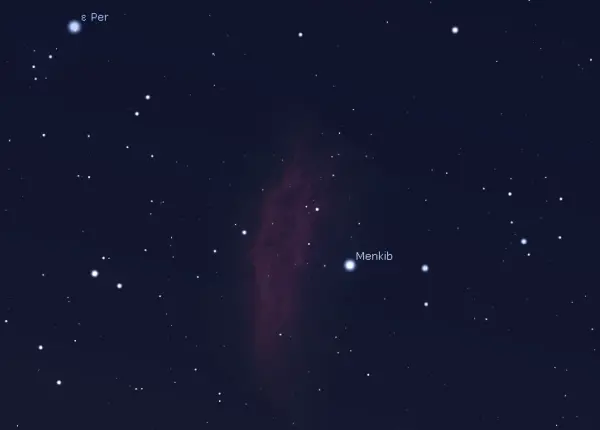
The California Nebula (NGC 1499), Menkib (Xi Persei), and Epsilon Persei, image: Stellarium
For northern observers, Perseus is visible for most of the year. The best time of year to observe the stars and deep sky objects in the constellation is during the month of December.
California Nebula – NGC 1499
| Constellation | Perseus |
| Right ascension | 04h 03m 18.00s |
| Declination | +36° 25′ 18.0″ |
| Apparent magnitude | 6.0 |
| Distance | 1,000 light-years |
| Apparent size | 2.5° |
| Names and designations | California Nebula, NGC 1499, Sharpless 220, Sh2-220, LBN 756, LBN 160.18-12.15 |